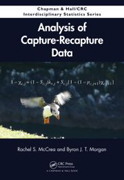
Provides an overview of modern statistical methods for the analysis of capture-recapture and related data Describes recent advances in the analysis of generalized capture-recapture data, including multistate and spatial models, occupancy models, state-space models, and integrated population modeling Covers model diagnostics, model selection, and checking goodness-of-fit and parameter redundancy Explains the complexities that arise when describing extensive modern data sets Includes further reading suggestions and exercises at the end of each chapter Offers the data sets, solutions to exercises, R code, and more on the book’s website Summary An important first step in studying the demography of wild animals is to identify the animals uniquely through applying markings, such as rings, tags, and bands. Once the animals are encountered again, researchers can study different forms of capture-recapture data to estimate features, such as the mortality and size of the populations. Capture-recapture methods are also used in other areas, including epidemiology and sociology. With an emphasis on ecology, Analysis of Capture-Recapture Data covers many modern developments of capture-recapture and related models and methods and places them in the historical context of research from the past 100 years. The book presents both classical and Bayesian methods. A range of real data sets motivates and illustrates the material and many examples illustrate biometry and applied statistics at work. In particular, the authors demonstrate several of the modeling approaches using one substantial data set from a population of great cormorants. The book also discusses which computer programs to use for implementing the models and contains 130 exercises that extend the main material. The data sets, computer programs, and other ancillaries are available at www.capturerecapture.co.uk. The book is accessible to advanced undergraduate and higher-level students, quantitative ecologists, and statisticians. It helps readers understand model formulation and applications, including the technicalities of model diagnostics and checking.
- ISBN: 9781439836590
- Editorial: CHAPMAN & HALL LTD.
- Encuadernacion: Tela
- Páginas: 314
- Fecha Publicación: 01/08/2014
- Nº Volúmenes: 1
- Idioma:
